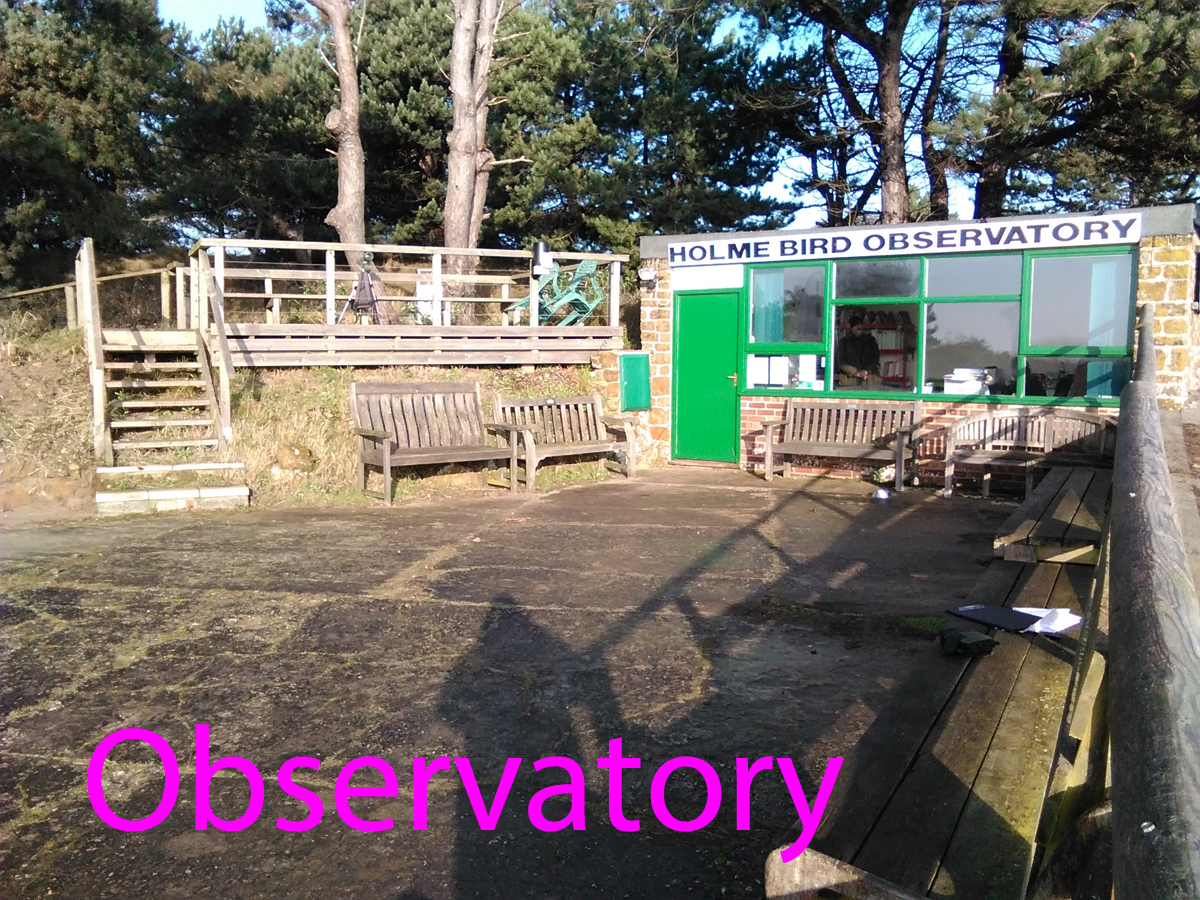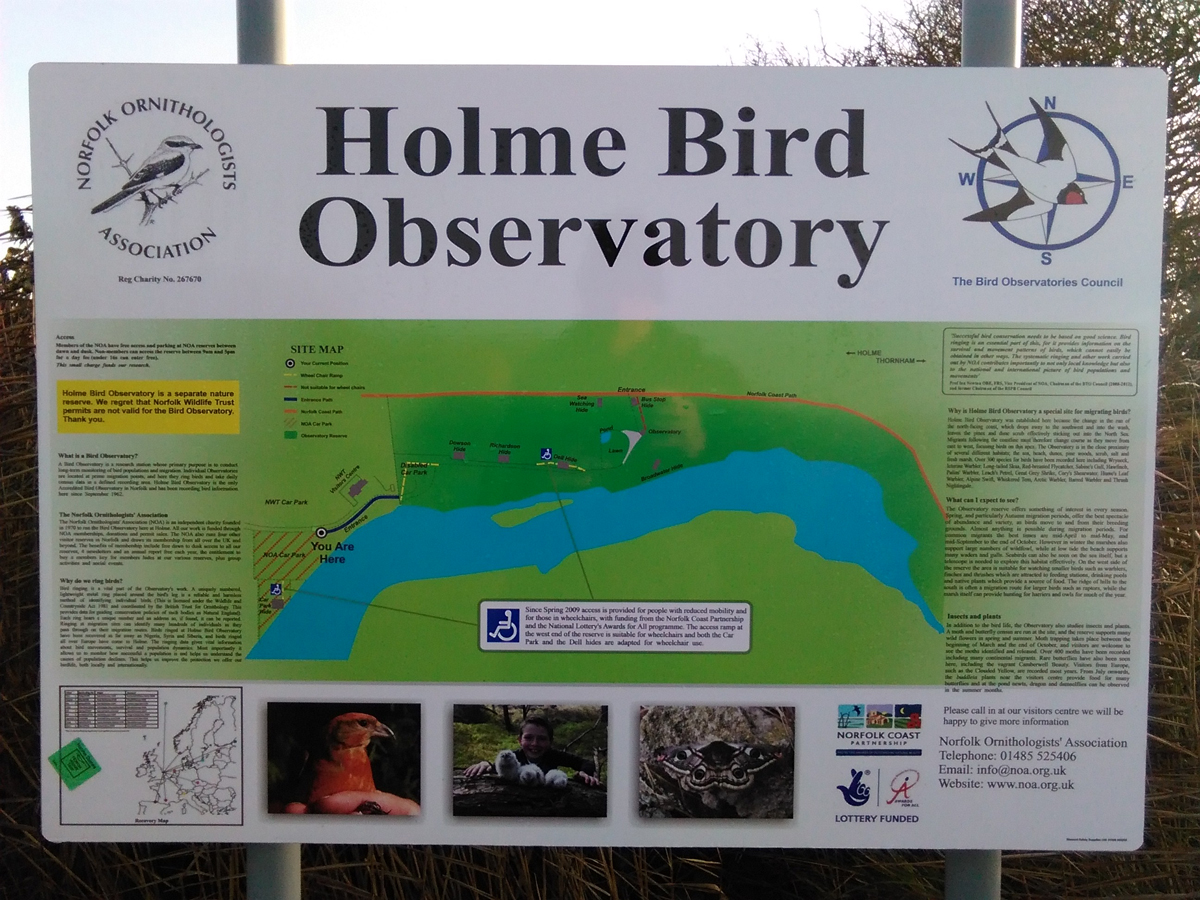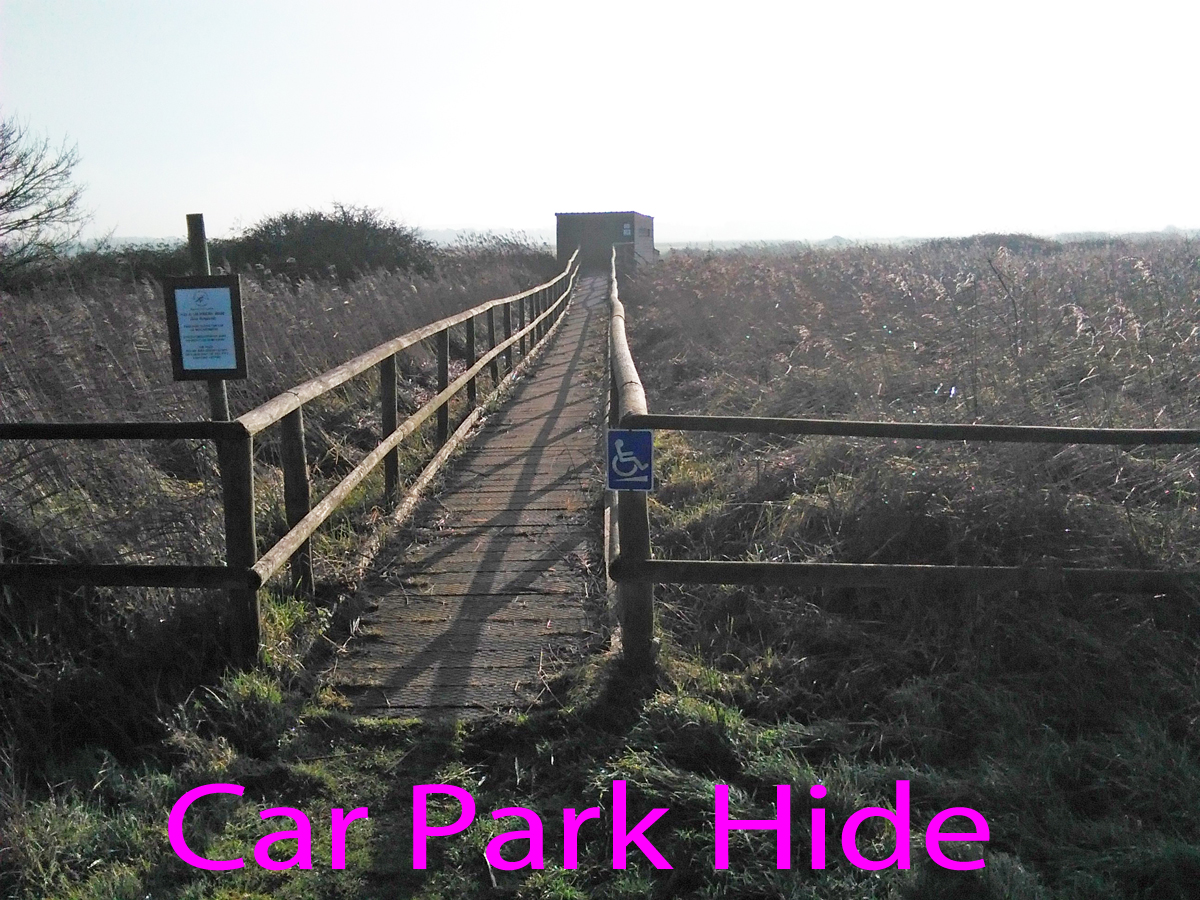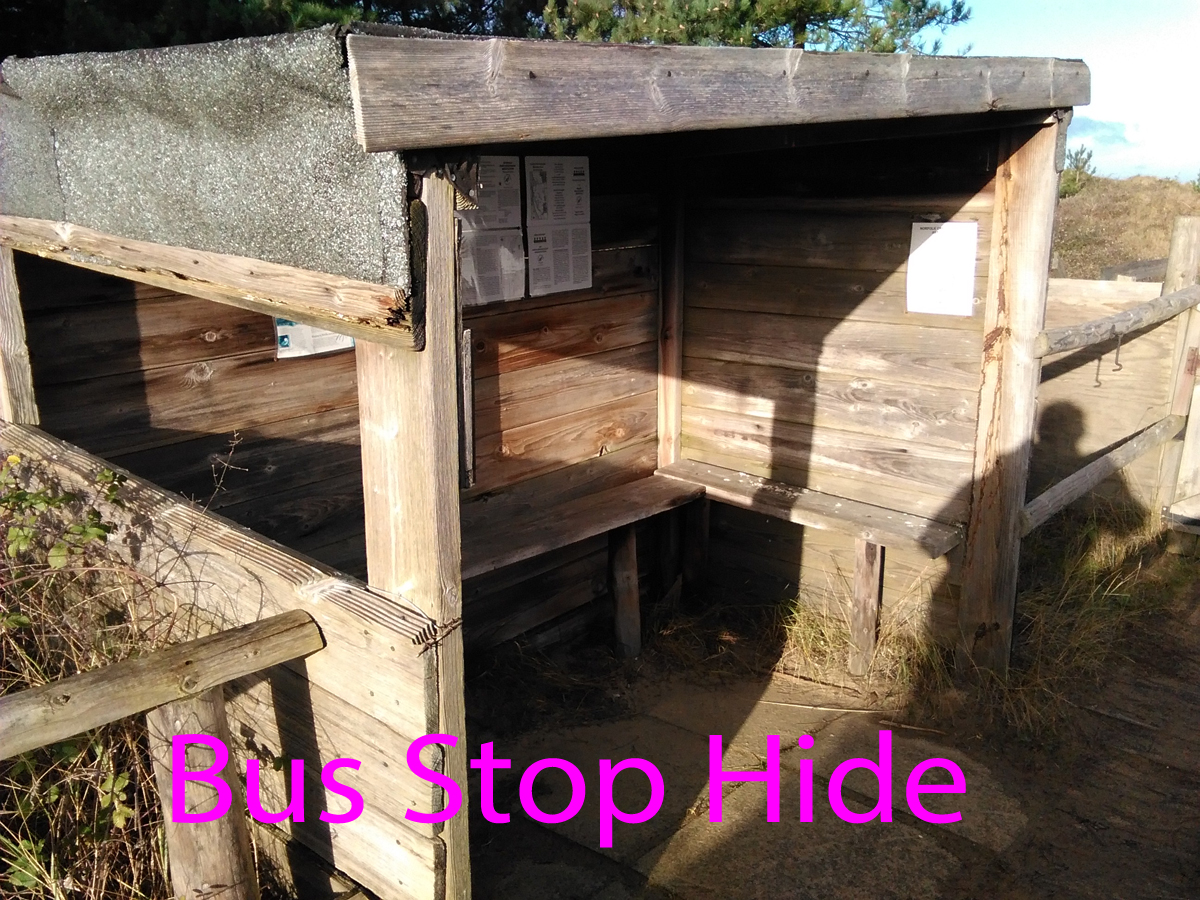Reserve Name: Holme Bird Observatory
Address: Broadwater Road, Holme-next-the-Sea, Hunstanton, Norfolk, PE36 6LQ
Phone Number: 01485 525406 (There is no public telephone on the reserve and mobile phone reception is very weak)
Email: info@noa.org.uk
Opening Hours: Dawn till dusk, but see note on NOA website about access. Those arriving before 10am will need to open and close a gate. This operation is not a wheelchair accessible one as the post to which the gate needs to be fixed when open is well back into the rough verge.
Website: Holme Bird Observatory
Map Reference: TF717450
Google Map: Holme Bird Observatory
The reserve was visited and assessed over a number of days during December 2016 by Peter Bangs.
Holme Bird Observatory is the only accredited bird observatory in Norfolk. It is owned and run by the Norfolk Ornithologists’ Association (NOA), an independent Norfolk-based charity, dedicated to the scientific study of birds. It focuses primarily on bird migration and population dynamics through bird ringing and daily monitoring. It is located within an extensive area of coastal habitats that are managed for wildlife conservation. The NOA owns a second reserve, Redwell Marsh, situated beside the access road to the Observatory. It is quite feasible to visit both reserves on the same day. Much work has been done over the years to make some of the hides, and most parts of the reserve, wheelchair accessible. For full details see below. Please also see the separate assessment for Redwell Marsh reserve for accessibility details there.
Location: Holme next the Sea, Norfolk.
Public Transport Links: The nearest bus stop is on A149, at the western end of Holme village. This is approximately 3 kms from the reserve, by the junction with Beach Road. The bus route is the Coasthopper, run by Stagecoach. Tel: 01553 776 980 Disability helpdesk Email: norfolk.enquiries@stagecoachbus.com Buses run from Kings Lynn (change may be needed at Hunstanton) or Wells.
At the bus stop there are raised paved areas (on each side of the road) to assist in boarding/alighting from the bus, but these are short and just end in an uneven grass verge. The road leading from the A149 towards the reserve (Beach Road) is narrow and twisting – in places a single-track road with a few passing places. There is no pavement, and for much of its length not even a grass verge. For this reason, it is not a suitable means of access for wheelchair users.
Parking: Plenty of parking is available in the NOA’s car park – on the right near the end of track, bounded by a post and rope fence. There is a second smaller car park for those with access issues, at the very end of the track. Just keep going past other car parks. They are marked (as ‘disabled parking’) on a map of the reserve on an information board in the main car park. To get to this car park do not turn into the main NOA car park on the right, nor the Norfolk Wildlife Trust car park on the left, but stay on the track, passing the NWT visitor centre (a white house) on your left. The ‘disabled car park’ is at the end of the track.
 All parking is free and there are spaces for minibuses. The surface of the main car park is very firmly compacted, partially grassed, sand and gravel, that is well drained, and quite smooth. It is accessible to most people using a wheelchair.
All parking is free and there are spaces for minibuses. The surface of the main car park is very firmly compacted, partially grassed, sand and gravel, that is well drained, and quite smooth. It is accessible to most people using a wheelchair.
Drop Off: Passengers can be dropped off at the smaller car park. This is the closest vehicle access to the Observatory.
Toilets: The nearest accessible toilet, and standard toilet, is at the Public Conveniences at the northern end of Beach Road, c.0.5km from reserve. There is no public telephone and the mobile signal is very weak.
Staffing: There is a full-time warden at the main NOA Observatory (who may be out on the reserve, or in the bird ringing lab, near the main Observatory building).
Visitor Centre: Visitors always receive a warm welcome at the Observatory building which has displays of locations where birds trapped were previously ringed etc, and where the warden can give details of recent sightings. It is not a visitor centre in the sense of being a shop and cafe, though there is some seating inside the building, as well as outside. The entrance door is on the narrow side – only 72cms unobstructed clearance, and there is a 15cms threshold, which may make entry for some wheelchair users difficult.

The Reserve
Overview
The NOA’s small Observatory building is set in a 13 acre (5 ha) reserve of pine and scrub-covered dunes between the shore and the Broad Water at Holme-next-the-Sea. The Observatory reserve lies immediately to the east of The Firs, the Norfolk Wildlife Trust’s Holme Dunes visitor centre. The Observatory is well situated owing to the change in the line of the north-facing coast, which drops away to the southwest and into the Wash, leaving the pines and dune scrub as a prominent magnet for migrating birds. The reserve is in close proximity to several different habitats, with the sea, beach, dunes, pine woods, scrub, salt marsh and fresh marsh all contributing to an incredibly varied wilderness. There are a number of rides in the dune scrub in which mist nets may be located, and also a Heligoland trap, built in 1997. The area is designated as a Site of Special Scientific Interest (SSSI).
It is, in effect, an oasis of Corsican pines and scrub set in a wilderness of sand dunes, the nearest main road being about a mile away across lush grazing marshes.
The northern boundary of the reserve is marked by the Norfolk coast path. To the east of the Observatory building is the east bank, formed by Thornham sea wall. This bank is covered in marram grass and bramble, with small pockets of privet, and at the foot of the bank taller vegetation follows the northern edge of the Broad Water. There is a dense area of elder and willow scrub at the east end of the reserve.
To the south, the Observatory looks over the Broad Water, a brackish lagoon which supports a variety of wildfowl and waders, and over the years has attracted such unusual species as Little Auk, Smew and Great Northern Diver. A sluice at the east end of the Broad Water controls the water levels. Further south beyond the A149 coast road there is a ridge of low hills, which run between Choseley and Ringstead almost parallel with the coast. Larger migrants such as raptors and even Common Cranes often follow this feature, using the thermals created by its topography. The ridge is best viewed from the platform adjacent to the Observatory building, which raises the observer just enough to afford a really good view for several miles to the south, southwest, and southeast.
Access
There are no leaflets but there is a large information/interpretation board, with a reserve map, in the main car park. (Guide dogs on close leads only are welcome)

The distance from main car park to the observatory is c.350 metres, but from the disabled car park it is c. 220 metres. From the main car park to the disabled car park is a very uneven track, but it is accessible to those who do not have particular walking difficulties. From then on the path is a well-drained and fairly level and smooth grassy path. To access this path from the disabled car park you need either to go up 10 steps (with a handrail about 85cms high) or use the by-pass access ramp consisting of a board walk 155cms wide with hand rails at 100cms high, and edge boarding to the sides. This boardwalk ramp is about 50 metres long, with a passing place about halfway. The boards are covered with wire mesh to maximize grip. The board walk has a dog-leg layout to reduce the gradient. Nearer the Observatory there is a break in the path, with 5 steps, but there is a gently sloping bypass boardwalk (115cms wide with edging upstands and covered in wire mesh.) After the steps/boardwalk bypass the surface is concrete right up to the Observatory. All paths are at least 70cm wide and for the most part at least 120cms (a small part of the concrete section is narower, but there is open smooth grass to each side of this. One point on the access slope to the raised deck area next to the Observatory building is just 900mm wide.)

There are no steep slopes (assuming you avoid the steps) on the main approach path, but the access to a raised viewing deck next to the Observatory building is by steps, or a paved slope that is quite steep. The boardwalk from the disabled car park (c50metres) has a moderate slope. The boardwalk that bypasses the five steps on the main path (c40 metres) has a gentle slope. There are no gates or stiles along the path, and by-pass slopes are provided wherever there are steps, as mentioned above. All paths are clear of any overhanging branches etc. Along the main path there are plenty of passing places.

Most of the paths are wide enough and level enough everywhere for a wheelchair user to stop and rest (and birdwatch!) without obstructing the path. There is a substantial wooden bench with backrest and arms c100 metres from the disabled car park. Between the disabled car park and that wooden bench there are two hides (Dowson Hide and Richardson Hide – see map below), each with a bench seat you can slide onto without lifting your legs. However, there are steps down from the main path to each of these hides, and no handrails. They are not accessible to wheelchair users, nor to those who are only be able to walk on level ground, About 30 metres beyond the wooden bench is another hide (Dell Hide), next to the second section of boardwalk, that is accessible to wheelchair users. Inside is a slide-in bench seat and two plastic chairs with backs.
Once you reach the Observatory building there are multiple wooden bench seats, with backrests and arms, outside the building, and some plastic chairs with backrests inside. To one side of the Observatory building is a raised decking area, with views over the reserve. The back edge of this deck is formed by a wide built-in bench seat with backrest.

Key to Hides:
1 Car Park Hide
2 Dowson Hide
3 Richardson Hide
4 Dell Hide
5 Broadwater Hide
6 Bus Stop Hide
7 Sea-Watching Hide
NB: The hides are usually kept locked. Members of Norfolk Ornithologists’ Association can purchase a key. For more casual access, you are advised to contact the warden in advance of your visit.
The Hides
Car Park Hide

This hide gives views over the Broad Water with possibilities of close views of waders in the muddy margins, and ducks and other water birds. Beyond the Broad Water there are views over grazing marshes. Access is by a level, 45 metre-long, boardwalk leading off the main car park. This has edge boards and hand rails and the boards are wire mesh-covered for grip. The boardwalk is about 110cms wide. The entrance has a platform 1.5m by 2m and there is no threshold step.
The outward opening door is 81cm wide. There is clear wheelchair access to viewing points with a 145cm wide wheelchair bay with angled knee space. The viewing shelf is 80cms from floor level and 15cms deep. However, the bottom edge of the viewing slot is 94cms from the floor with a 35cms high view and a 150cms-wide flap. There is an easy to grip latch but the top latch is 165cm from the floor. The benches are fixed and there are no gaps to swing legs through. However, there are three light plastic chairs with backs. There is sufficient space to turn a wheelchair within the hide.
Dowson Hide
This hide is not wheelchair-accessible.
The hide gives views over a thick scrub, which often attracts migrants, towards mature pine trees. There are steps down to the hide from the main reserve path – 7 steps on one side, 4 on the other. There are no handrails. Inside there is a ‘slide-in’ bench with gaps at each end but nothing with a backrest.
Richardson Hide
This hide is not wheelchair-accessible.
The hide gives views over a thick scrub, which often attracts migrants, towards mature pine trees. There are 3 steps down to the hide from the main reserve path. There is no handrail. Inside there is a ‘slide-in’ bench with gaps at each end but nothing with a backrest. There is an open doorway.
Dell Hide
This hide gives similar views to both Dowson and Richardson hides. In addition there is a feeding station in a small clearing in front of the hide. It is accessed directly from the boardwalk section of the main reserve path, which gives plenty of room for wheelchair manoeuvring. There is no threshold step and an inward opening door 84cms wide. There is clear access to viewing points and a 160cms wide wheelchair bay with a roomy angled knee space. The shelf is 92 cms off the floor and 15cms deep. The viewing slot is 34cms high with double flaps, each of 80cms width. The retaining latches are 165 cms above the floor. There is a slide-in bench with two plastic chairs with backs.
Broadwater Hide

This hide gives views over the Broad Water and grazing marshes beyond and access is over a sloping area of grass. The hide is not wheelchair accessible as there are 6 wooden steps up into the hide, with a handrail c100cms above the steps and an open doorway. There is no slide-in gap to the bench and no chairs with backs.
Bus Stop Hide

This hide gives limited views over part of the Broad Water and the grazing marshes beyond, plus limited views over the dunes. The name reflects the look of the hide as it is an open-fronted shelter, facing east. The hide can be accessed from the boardwalk that leads up from beside the Observatory to the entrance into the Reserve from the Norfolk Coastal Path. It should be noted that this boardwalk is not suitable for wheelchair users, (and is clearly labelled thus). It is narrow and steeply sloping, with no passing places or rest points. There are handrails, at 100cms high, which may help some people access this path on foot. There is fixed bench seating along the three internal walls of the hide and uses the hide walls as backrests.
Seawatching Hide

This hide was built specifically for sea watching. It is on a 3 metre-high platform to give views north over the dunes to the sea only accessible via the staircase so is not wheelchair accessible. Access is via a fairly steep path up from the Observatory, then by climbing 14 wooden steps, each 54 cms wide. There are handrails on each side at about 80 cms above the steps. The outward opening door is just 55cms wide. The bench seat does not have gaps that allow users to slide in without lifting their legs over the seat.
